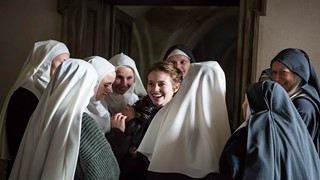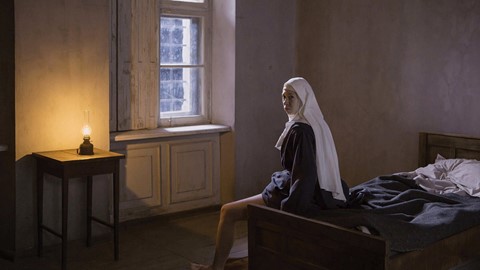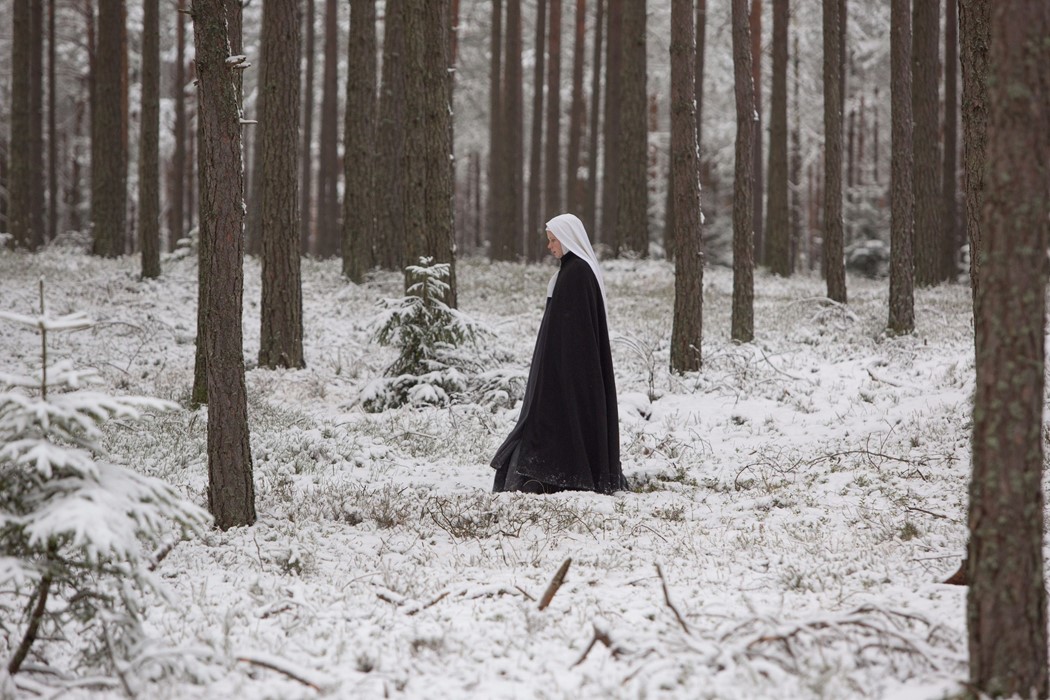As Anne Fontaine’s newest film arrives in the UK, we sit down with the Coco Before Chanel director to discover the extraordinary tale that inspired it, and its remarkable realisation
Today sees the release of the new film from Anne Fontaine, the celebrated director behind Coco Before Chanel and Gemma Bovery. Titled The Innocents, it is the haunting rendition of a real-life story, adapted from the diaries of French Red Cross doctor, Madeleine Pauliac – renamed Mathilde Beaulieu in the film, and played by a captivating Lou de Laage – who was drafted to Warsaw in the aftermath of the Second World War. One day, while attending to her military patients in the makeshift hospital there, Mathilde is beckoned outside into the snow by a Benedictine nun, who desperately pleads with her to help one of her fellow sisters. The young, atheist doctor reluctantly agrees and, upon arriving at the convent, is confronted by a shocking discovery: said sister is in labour, while several other nuns are also pregnant, the victims of a hideous cruelty. As the story unfolds, Mathilde and the nuns she secretly tends to must learn to trust each other, overcoming the boundaries of language and faith, in what proves a hard-to-watch but deeply moving tale of female solidarity, with some shocking twists and turns.
Fontaine was first introduced to the story by producers, Éric and Nicolas Altmayer, who invited her to lunch with the promise of an idea she wouldn’t be able to refuse. “Of course, I was very curious,” the Luxembourg-born, Paris-based director tells us, seated cosily in a leather arm chair in an upstairs cafe at Picturehouse Central. “They began to describe the facts of the situation: of these nuns, at the end of the war, pregnant. And my first question was: ‘how do you know this?’ They explained that they had met Philippe Maynial, the nephew of Madeleine Pauliac, who told them that he had been trying to make a movie from his aunt’s diary for four or five years but hadn’t been able to do so.” (Maynial had been working with two writers to develop a script, which would later form the basis of Fontaine’s final screenplay.) Fontaine was intrigued and began to research further into the backstory of this sinister event. “I was struck by the intensity of the situation,” she says, “and its universality in terms of the treatment of women during wartime, even to this day. I felt I could do a movie that speaks of that period but also of today, which is why I took it on.”

Before shooting commenced, Fontaine spent some time living in French nunneries, acquainting herself with the nuns residing there. The “deep relationships” she went on to forge helped her to understand the hierarchies at play within convent life and the individuality that lies beneath the nuns’ uniform attire. “We talked about maternity and what it means to never experience it, and the fragility of faith too; how you can keep the faith from year to year,” she says of the experience. “It helped me to be true to their world; not to parody it too much. The Vatican saw the film and they said to me that it’s very true to the point of view of religious life, which was very important to me because I didn’t just want to be a tourist in their world.”
The next step was to cast her actors: a more exacting task than the auditioning process for her previous films, firstly because of the fact that so many of the actors had to speak Polish, a language she did not understand, and secondly because the faces of the women playing the nuns were so vital to the telling of the story. “They had to be different; to be really expressive, and to show what is under the skin, because you can’t see their bodies under their clothes.” One of the most extraordinary performances comes from acclaimed Polish actress Agata Kulesza (known for her role as the outgoing Communist Party member Wanda in Pawel Pawlikowski’s Oscar-winning drama Ida), who plays the cool and unmoveable mother superior. “When I met her, in a bar, I thought, she can’t do this character: she’s too young, too sexy. I said to her: ‘Agata, I like you very much but for this part, I don’t see how it’s possible.’ But she said, ‘Wait, let me try. I’ll do some screen tests without make-up, only for you.’ And when she sent me them, it was amazing: it wasn’t the same face; without make-up, you only saw her expressions, and I knew she would be fantastic.” Her other Polish cast members include Agata Buzek, whom Fontaine describes as Poland’s Cate Blanchett (“she’s very very charismatic”), and the similarly captivating Joanna Kulig and Katarzyna Dąbrowska. The development of trust between them was very important, the director explains, because, not being able to speak Polish, she couldn’t direct the delivery of their lines. “That’s good for a director though, because a director is a control freak,” she says matter-of-factly.

Another gargantuan task for the filmmaker and her director of photography, Caroline Champetier, was finding a location in which to shoot; so much of the film is set within the walls of the convent, that it was vital to find the right space. “We made two or three trips to Poland and made a list of all the convents we might be able to use, but of course they were all working convents, and didn’t want us to shoot there. Then we found this one that was abandoned, which was right in the middle of a forest and very true to the story.” But there was a problem: “the structure was there, but there was no inside – just the façade,” Fontaine laughs. “Then my DP said to me: ‘what if we construct the interior ourselves?’ I said, ‘that would be mad; a very big step!’ But we did – with a very good location producer, a Polish woman who worked on it, directed by us. And on top of that, we constructed the hospital in an abandoned train station… Everything seems authentic, but it isn’t!”
The pair were similarly meticulous in their scene set-ups and selection of props, using a reference book filled with everything from “a simple picture of a bench or a cross” to paintings by Georges de La Tour (the inspiration behind the powerfully theatrical, Caravaggesque lighting) and iconography of the Virgin and Child. “Every object, every piece of furniture had to be true,” the filmmaker explains, “it had to be very minimal and very pure.” And indeed, the sparsity of the setting, paired with the cold, wintry atmosphere – both of which are beautifully captured by Champetier – prove integral in allowing the habited actors our undivided attention in their rendition of such an emotionally complex tale.

The shooting itself took eight weeks, and was for Fontaine another unique experience. “In my movies, I always have female characters, strong female characters with big decisions to make, but I have never worked with a group of women before in the same way.” As it turned out, being isolated in the middle of the Polish countryside cultivated the perfect sense of female camaraderie required to shoot such an intense and gruelling film, with sisterhood at its heart. “Everyday I would come back from the shooting and find the cast around the table – the Polish actors and Lou – and we would talk. I felt very comfortable because they were intelligent about their characters and they were very creative and very concerned about the story. We were at the end of nowhere, always together in the same boat for weeks. It’s something special to be in a convent every day, plus the cold in winter creates solidarity, and I think they were impressed by the fact that a French director was with them in this story. The feeling [that pervades among the women] in the film was mirroring real life, which was really incredible.”
The Innocents is in cinemas nationwide from today.
